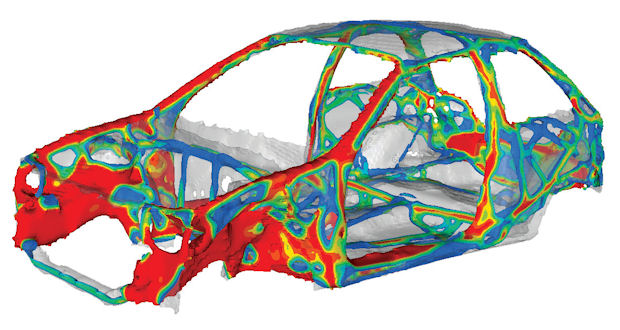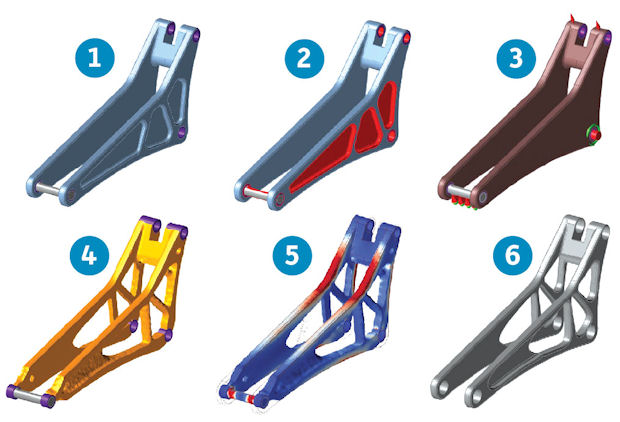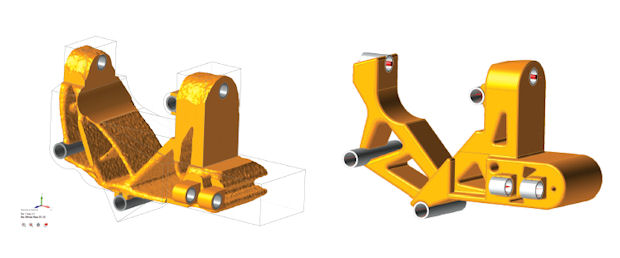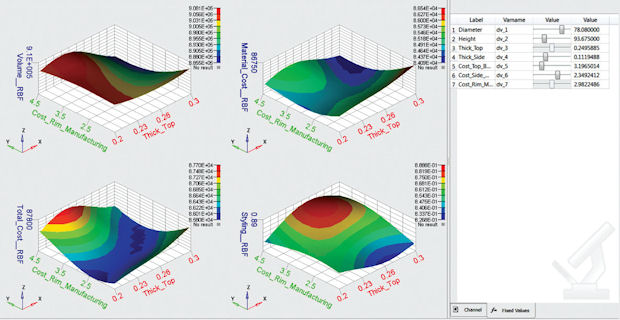Latest News
December 1, 2014
 There’s no question that simulation-driven design has dramatically altered the engineering landscape, helping companies condense development cycles, better refine products, and greatly diminish costs.
There’s no question that simulation-driven design has dramatically altered the engineering landscape, helping companies condense development cycles, better refine products, and greatly diminish costs.
Optimization is the next logical step, driving a paradigm shift that replaces trial and error engineering with a new way of thinking about design problems. In lieu of the traditional iterative process in which engineers create, test, and validate designs only to identify problems, make changes, and start all over again, optimization-led design challenges engineers to formulate problems in a different manner. By following a systematic set of steps—from identifying what could change as well as the design goals and non-negotiable requirements—optimization leads organizations down a different path. It leads them toward greater innovation, the exploration of lightweighting opportunities and the discovery of potential failure modes that might not be visible to the average design engineer.
 Altair OptiStruct is a proven structural analysis solver that can be used for complex linear and non-linear problems under static and dynamic loads.However, the dynamic duo of simulation and optimization has primarily been limited to domain experts, often only tapped mid-stream or later in the design cycle. Limited access to these tools and proven design practices compounds the highly iterative and time-consuming design process, requiring multiple hand-offs between design engineers and CAE specialists, which does little to streamline workflows or help teams achieve optimal results.
Altair OptiStruct is a proven structural analysis solver that can be used for complex linear and non-linear problems under static and dynamic loads.However, the dynamic duo of simulation and optimization has primarily been limited to domain experts, often only tapped mid-stream or later in the design cycle. Limited access to these tools and proven design practices compounds the highly iterative and time-consuming design process, requiring multiple hand-offs between design engineers and CAE specialists, which does little to streamline workflows or help teams achieve optimal results.What if organizations could break this cycle, bringing simulation and optimization to the wider pool of non-experts? By putting these practices well within reach of mainstream design engineers, not just domain specialists, companies could unleash the power of optimization-driven design throughout the entire development process, particularly during the early design stages when it’s easier and less expensive to make changes.
Optimizing early provides a variety of benefits. Design concepts are more likely to meet requirements, minimizing the back and forth between team members. Optimizing during the early concept stage also gives engineering organizations a jumpstart on identifying optimal structure, system, materials distribution, and weight targets while improving safety, durability, and other performance attributes. The end result is a streamlined development process, which cuts back on costly prototypes and ensures aggressive time-to-delivery objectives are met.
Barriers to Mainstream Adoption
Despite the many benefits, there have been long-standing barriers to the adoption of early-stage simulation and optimization as a mainstream practice. Time is a major hurdle for most organizations, which are under constant pressure to compress development cycles to stay abreast of the competition. Without access to the proper tools, moving to an optimization-driven design culture is a challenge for most organizations, which are already struggling to release roducts in a timely fashion.
In addition, existing simulation and optimization tools are primarily tuned for an expert audience, not the mainstream user. Most simulation and optimization offerings wrap highly sophisticated functionality in a complicated user interface that is out of reach for the average design engineer, who doesn’t have the time or the inclination to master the tools let alone learn highly specialized skills.
 Altair’s solidThinking Inspire can be used to 1. import or sketch a part, 2. defeature it, 3. assign materials and loads, and 4. then generate an ideal shape with the click of a button using mathematical optimization. Once a shape has been optimized, Inspire can help 5. confirm the part’s performance so that the part can be 6. refined in a CAD program.
Altair’s solidThinking Inspire can be used to 1. import or sketch a part, 2. defeature it, 3. assign materials and loads, and 4. then generate an ideal shape with the click of a button using mathematical optimization. Once a shape has been optimized, Inspire can help 5. confirm the part’s performance so that the part can be 6. refined in a CAD program.The “2013 Simulation-Driven Design” study, conducted by Lifecycle Insights, highlights many of these challenges. Sixty-one percent of respondents to the survey said their simulation analysts do not have enough time to run simulations frequently enough, with more than half (53%) claiming their fast-moving design cycles just can’t accommodate a protracted simulation process.
 Using Inspire, an engineer can iterate an optimized concept like the trunnion on the left, which can be the impetus to create the final, functional design (right).
Using Inspire, an engineer can iterate an optimized concept like the trunnion on the left, which can be the impetus to create the final, functional design (right).Nevertheless, organizations’ enthusiasm for simulation- and optimization-based concept design is not dampened by these challenges. According to the Lifecycle Insights survey, 70% of survey respondents called the practice essential for avoiding development delays and reducing the costs associated with testing, prototyping and change orders. Almost half (48%) said simulation and optimization were instrumental for lowering product costs, helping to reduce material requirements and allowing for the specification and purchase of right-sized components.
Optimization-Ready Solvers for All Stakeholders
Altair, a leader in the simulation and optimization space, is committed to changing the dynamic. The company has set its sights on opening up simulation and optimization practices to mainstream engineers, fostering their use throughout the entire development workflow.
For traditional CAE experts, Altair offers OptiStruct, a proven structural analysis solver that tackles complex linear and non-linear problems under both static and dynamic loads. With its built-in finite element and multi-body dynamics technology combined with advanced optimization algorithms, OptiStruct lets engineers analyze and optimize structures and mechanisms for their strength, durability and noise, vibration and harshness (NVH) characteristics.
While OptiStruct has the muscle to tackle the most complex design problems, Altair’s solidThinking Inspire unleashes the power of simulation and optimization on a far simpler scale. Built on the same algorithms and optimization kernel as OptiStruct, Inspire masks the complexity surrounding simulation and optimization and makes it palatable for a less simulation-savvy audience. For example, the software treats tasks like creating meshes and boundary conditions in a way that’s familiar to non-experts so they can immediately dive in. Through its intuitive user interface, Inspire performs such tasks with the click of a button, opening up a world of optimization possibilities for design engineers without any handholding or direction from time-strapped simulation experts.
In addition to its intuitive user interface, Inspire delivers simulation and optimization capabilities that meet the needs of design engineers. It can depict stress distribution, displacement, or deformation characteristics like traditional CAE tools, plus Inspire helps design engineers determine the optimal load path and where materials can be removed to improve the design.
 Altair HyperStudy helps engineering teams examine trade-offs among multiple disciplines to understand the ramifications their decisions will have on the entire system.
Altair HyperStudy helps engineering teams examine trade-offs among multiple disciplines to understand the ramifications their decisions will have on the entire system.Key to this ability are Inspire’s concept generation techniques, which find the best material distribution in a design space for a given set of loads. With Inspire, engineers simply define a design space that represents the volume where a design could exist, and establish the loads and other boundary conditions. The software figures out the optimal shape via mathematical optimization.
Inspire’s free-form shape approach is in direct contrast to CAD tools, which work with parametric shapes defined by parameters such as length or diameter. While shape dimensions can be varied using CAD solutions, the overall shape remains constant, diminishing how far teams can go with optimization. In comparison, Inspire helps design engineers easily identify the optimal shape that balances the greatest strength with the least amount of material—all via a few mouse clicks.
Put to work in the early concept stage, Inspire’s topology optimization capabilities help ensure the design process starts with a concept that comes very close to established performance targets. This helps to dramatically reduce overall development time, provides a more cost-effective way to study multiple concept possibilities, and zeros in on material-optimized designs that weigh less and cost less.
A Continuous Optimization Workflow
The real promise of Altair’s simulation and optimization strategy comes when OptiStruct and Inspire are used by both sets of users as part of a continuous engineering workflow. Design engineers can work with Inspire to come up with concepts that meet basic performance requirements, while CAE experts pick up where they leave off, leveraging OptiStruct’s more advanced functionality like non-linear optimization to further refine designs. To complete the picture, Altair offers HyperStudy, a multi-disciplinary design tool that provides optimization and design-of-experiment functionality to help engineering teams examine trade-offs among multiple disciplines like fluid or multi-body dynamics.
In the early stages of a new design, many factors need to be considered, such as weight, fuel consumption, packaging, structural performance, ride and handling, cabin noise and vibration. The requirements of these factors often conflict with each other, and it is not easy to find the right tradeoff between the wish lists, market requirements, and compulsory regulations. To find the right system design, engineers need to explore design alternatives for the entire system and understand the trade-offs. Once a design alternative that strikes an acceptable balance is identified, targets can be cascaded to sub-systems and components for further optimization. In this scenario, HyperStudy plays a role in creating the trade-off curves, and OptiStruct and Inspire handle the structural sub-system and component concept design and optimization.
Polaris, a snowmobile manufacturer, is one company driving efficiencies and design improvements throughout its engineering workflow thanks to the use of OptiStruct and Inspire. On a specific chassis project with pretty rigorous weight reduction goals, Inspire was tapped during the concept stage to quickly identify the basic shape and engineering, while OptiStruct was brought in to refine the shape for manufacturability and stress requirements. Inspire and OptiStruct were also paired to help evaluate the weight-reduction potential of using aluminum as a substitute for steel in several subassembly structures.
Not only did OptiStruct and Inspire help Polaris engineers substantially reduce the weight of the structures, it also greatly reduced the number of design iterations—going from 10 to 12 cycles with the traditional CAD/FEA loop down to five or six with Altair’s optimization-infused analysis tools.
As Polaris and others are fast discovering, simulation and optimization work best as an integrated team that is put to use continually throughout the design workflow. By democratizing the practices so they are within reach of mainstream engineers, not just experts, companies can achieve dramatic engineering efficiencies that will steer them on a course to greater innovation.
For more information, visit Altair.com/optimize.
Subscribe to our FREE magazine, FREE email newsletters or both!
Latest News
About the Author
DE’s editors contribute news and new product announcements to Digital Engineering.
Press releases may be sent to them via [email protected].






